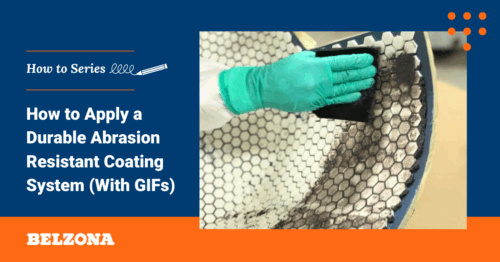Metal loss on pipework externals can be caused by abrasive and impact damage, as well as corrosion and other wear mechanisms in the in-service environment. If left untreated, thin-wall and even through-wall defects can develop, potentially leading to leaks which can be harmful to profitability, employee wellbeing and the environment.
This blog post provides a step-by-step guide to repairing metal loss on pipework using Belzona’s surface-tolerant epoxy metal repair material, Belzona 1161 (Super UW-Metal) and Belzona 9341 (Reinforcement Tape).
What is the surface-tolerant metal repair composite, Belzona 1161 (Super UW-Metal)?
Belzona 1161 (Super UW-Metal) is specifically engineered for the repair and rebuilding of metal surfaces contaminated by water or oil. This solution is ideally suited to pipe and shaft rebuilding applications, forming a reinforced composite wrap which can provide maximum pipe strength and pressure retention.
What are the main benefits of Belzona 1161 (Super UW-Metal)?
- Bonds strongly to wet, oily and manually prepared surfaces including metals such as stainless steel, carbon steel, aluminium, brass, copper and other rigid surfaces
- Can be applied and cured at room temperature or underwater with no hot work involved
- Provides excellent corrosion protection
- Offers resistance to a wide range of chemicals
More information about Belzona 1161 (Super UW-Metal) can be found online, or by watching this video where the solution is used to repair a leaking tank.
How to Repair Metal Loss on Pipework in Nine Steps
STEP 1:
Firstly, the damaged area must be located and clearly marked off. The repair area should then be masked off using tape to prevent excess product coming into contact with the pipework.

STEP 2:
The surface of the repair area should be prepared using an appropriate power tool to provide a roughened surface at SSPC-SP 11 standard, allowing for good adhesion to the substrate.

STEP 3:
Measure out Belzona 1161 (Super UW-Metal) at a ratio of two parts base to one part solidifier and mix the components together using a Belzona spatula in the recommended figure of eight motion. This should be continued until a uniform, streak-free colour is achieved.

STEP 4:
Wash down the repair area with Belzona 9111 (Cleaner/Degreaser) to remove any surface contaminants such as dirt and grease.

STEP 5:
Dry fit the Belzona 9431 (Reinforcement Tape) to the repair geometry and cut two wraps.

STEP 6:
Apply a thin layer of Belzona 1161 (Super UW-Metal) to the repair area, pushing the product well into the prepared surface profile to allow for good adhesion to the metal.

Then wet out the first wrap of Belzona 9341 (Reinforcement Tape) with the paste-grade product, ensuring that one side is entirely coated.

STEP 7:
Apply the first wrap of the coated reinforcement tape to the repair area, making sure to pull tightly so that the paste-grade product is forced through the tape to the surface. The reinforcement tape should be wrapped at a 50% overlap rate to ensure a strong and durable repair. Once the first wrap has been applied, smooth out any excess product and apply the second coated wrap in the same manner.

STEP 8:
Overcoat the repair with an additional layer of Belzona 1161 (Super UW-Metal), and smooth out any peaks and cavities using a Belzona applicator. Ensure that the Belzona 9341 (Reinforcement Tape) is fully encapsulated by the paste-grade product, with no visible creases or valleys.

STEP 9:
Remove the masking tape and allow the product to fully cure in line with the Belzona Instructions For Use (IFU) document before the equipment is returned to service.

You can View the Application in Action by Watching this Short Video:
For Detailed Guidance on Belzona’s Selection of Repair Composites and Protective Coatings

Having joined Belzona in 2010, Ian Wade has cultivated a deep expertise in corrosion, coatings, and inspection services. Currently serving as the Technical Services Manager at Belzona’s headquarters in Harrogate, Ian has held various roles. These include Technical Services Engineer and Training Facility Team Leader, where he managed the day-to-day operations of the training facility and collaborated closely with technical and business development teams.
Ian’s professional journey has taken him across the UK and international waters, including stints in South Korea, China, the North Sea, and the Caspian Sea, performing both supervisory and hands-on inspection work. His practical experience extends to on-site applications using Graco spray pumps and hand-applied coatings, directly enhancing operational standards and safety.
Ian is an AMPP (NACE) Certified Coating Inspector Level 2 and is currently advancing his knowledge by pursuing a Bachelor of Engineering in Mechanical Engineering part-time at The Open University, expected to complete in 2027. He has written a number of technical articles including: Strengthening the Bond with Reliable Structural Adhesives and The Benefits of Protecting Storage Tanks with Sprayable, Polymeric Coatings. His commitment to technical excellence and his robust experience make him a valued leader and innovator in his field.



